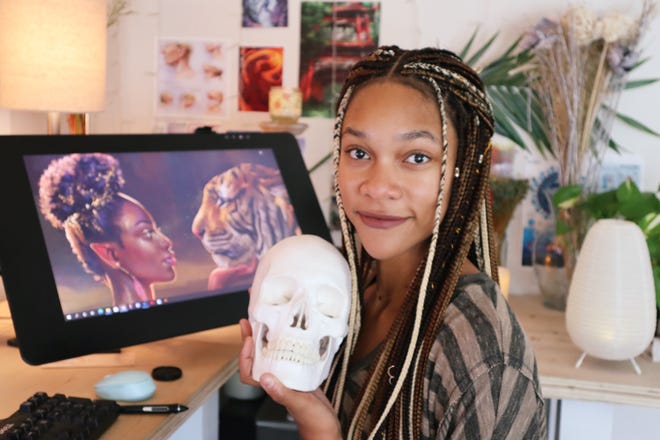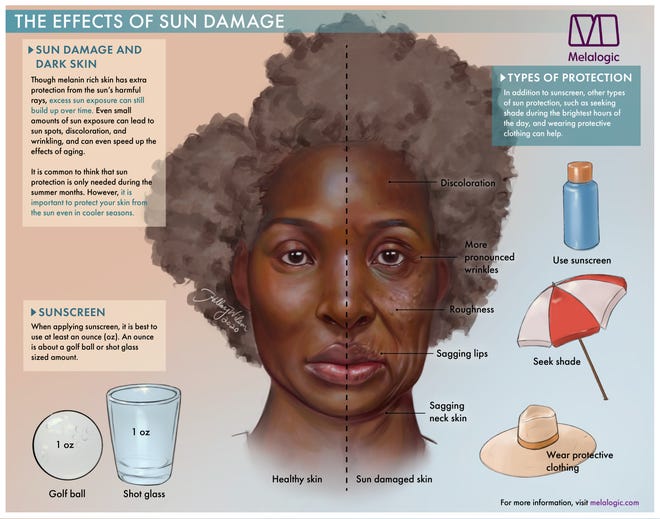You’ve probably seen medical illustrations in textbooks or at the doctor’s office, but have you ever seen one featuring a person of color?
Last month, an illustration of a pregnant Black woman went viral on Twitter and many users commented that they’d never seen an image like it. The image, created by future Nigerian medical student and illustrator Chidiebere Ibe, has drawn attention to efforts by artists of color to bring more diversity to the drawings, which can impact patient care.
Medical illustrations predominantly depict white male bodies, Black illustrators say. Less than 5% of images in four of the medicine textbooks assigned at top medical schools in the United States show dark skin, researchers found in a 2018 study.
Ibe, who will attend Kyiv Medical University in Ukraine next month, became interested in medical illustration in July 2020 and spent a year teaching himself to draw anatomy. From the start, he realized that there was a lack of diversity in the images he was studying.
“Because of the lack of representation, the learning process were very difficult for me,” he told USA TODAY. “During that process, I realized that there was a problem somewhere that needed to be addressed.”
Not just Tuskegee:America has a history of medically abusing Black people.
Ibe, 25, began advocating for more inclusive medical literature and sharing his work on social media. But he was surprised that his drawing of a Black pregnant woman and fetus got the most attention. The image was retweeted more than 47,000 times and attracted more than 332,000 likes.
Although he’s received some negative comments, Ibe said he’s been inundated with positive responses, including people who said the images made them feel valued and inspired their children to study medicine.
“I never expected that,” he said. “I felt just amazed.”
‘It’s hard to be what you can’t imagine’:America has an urgent need for Black doctors

Anatomy drawings have been used for thousands of years, but medical illustration wasn’t established as a profession in the United States until the late 19th century, according to the Association of Medical Illustrators, which has about 800 members.
The AMI launched a diversity committee in 2018 that has been pushing illustrators to include more variation in their work for several years and doing outreach in schools to increase diversity in a field not many people are familiar with, said committee chair Ni-ka Ford.
Illustrations — as well as animations, augmented and virtual reality simulations — are used in training material for medical professionals as well as in patient educational material, pharmaceutical company advertisements and even in legal settings.
Like the larger medical field, medical illustration is predominantly white. There are fewer than 2,000 trained medical illustrators worldwide and Ford estimated less than 8% are people of color.
“If you don’t have diverse people creating this content you’re not going to see as much diversity within the content being created,” she said.
The disparities persist even in literature related to diseases that affect people of color more often. Despite the fact that COVID-19 disproportionately sickens and kills people of color, an analysis published by in the British Journal of Dermatology in 2020 found articles describing the rashes associated with the coronavirus almost exclusively show clinical images of patients with lighter skin.
Hundreds of communities declared racism a public health crisis:What are they doing about it?
Ford, who has been a medical illustrator for four years, said the lack of diversity is a “huge problem” that can perpetuate a cycle of implicit bias which “does at the end of day affect patient health.”
“The medical provider may not know how to accurately diagnose someone with darker skin if they’ve never been exposed to that in their training,” she said. “For patients, if they don’t see themselves reflected in these materials, it can really create a sense of isolation and distrust in their health care provider.”

Hillary Wilson, a 27-year-old medical illustrator based in Durham, North Carolina, was studying biology and planning to go to medical school when she first learned medical illustration was a potential career that could combine her love of art and science.
Wilson said many people ask why she showcases a wide variety of skin tones in her work, which primarily involves patient education. For her, the illustrations feel incomplete without it.
“It just makes sense to try to account for the fact that there’s so many different people,” she said. “Why wouldn’t I include these other examples? As a Black person, if I were to be doing something using an arm as reference, it’s probably gonna be my arm.”

Wilson said shehopes the attention Ibe’s illustration has received will help stop people from seeing white skin as the “default.”
“Sometimes I think that people feel as though there needs to be a reason for why you’ve chosen to make somebody not white in an illustration,” she said. “They just exist … people of color, marginalized people don’t need a reason to be there.”
Ibe wants to help further normalize the images by producing textbooks and public health materials for community health centers around the world. He said he also hopes to start a scholarship fund to “give back to my roots.”
“This is no longer just my project, but the community’s project,” he said.
Follow N’dea Yancey-Bragg on Twitter: @NdeaYanceyBragg

